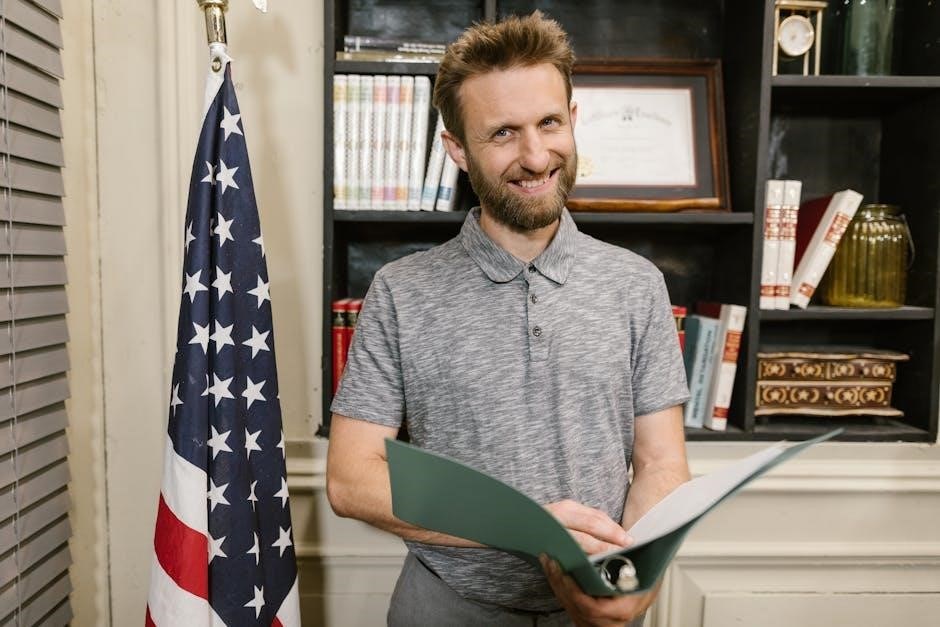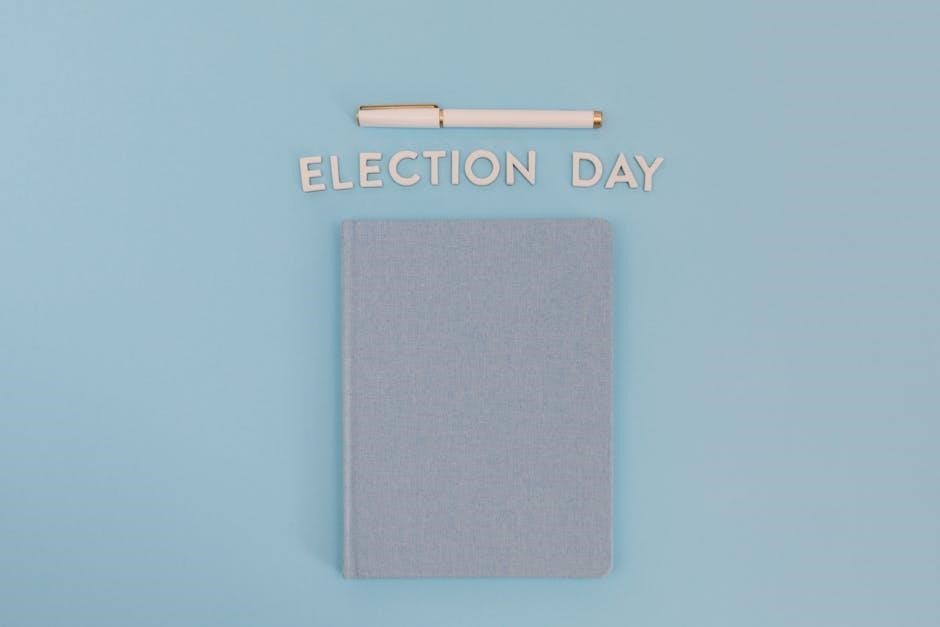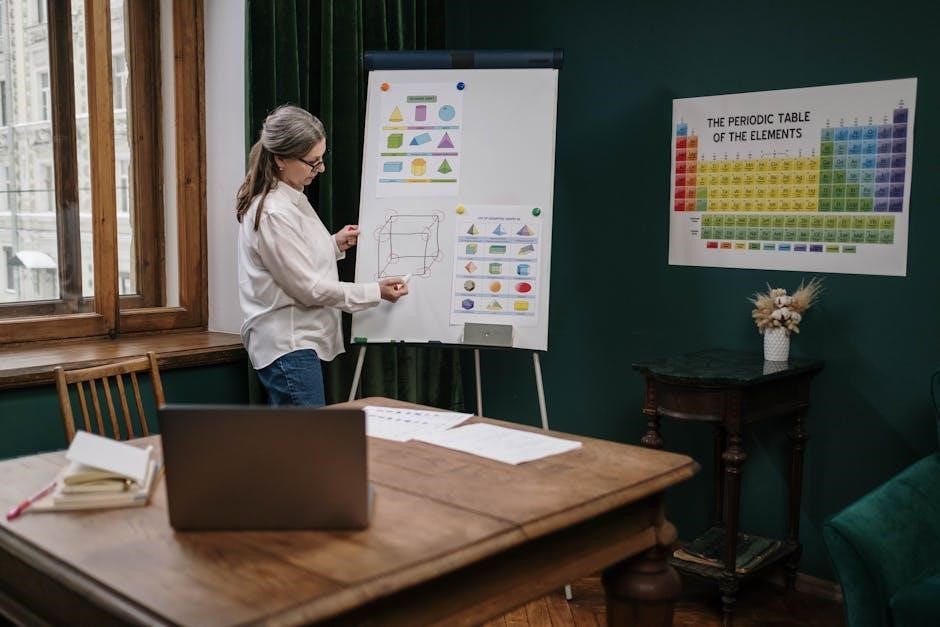unit 6 study guide government
This unit explores the foundational concepts of government‚ including its structure‚ functions‚ and significance in shaping society. It introduces the three branches‚ constitutional principles‚ and the role of citizens in governance‚ emphasizing civic responsibility and informed decision-making.
1.1. Overview of Government Structure
The U.S; government is structured around the principle of separation of powers‚ divided into three branches: legislative‚ executive‚ and judicial. This framework ensures checks and balances‚ preventing any single branch from abusing power. Federalism further divides authority between federal and state governments‚ promoting localized governance while maintaining national unity. Understanding this structure is crucial for grasping how policies are formed and how power is distributed‚ fostering informed civic participation and accountability.
1.2. Importance of Understanding Government
Understanding government is essential for active citizenship and informed decision-making. It empowers individuals to participate in democracy‚ protect their rights‚ and hold leaders accountable; Knowledge of government structure and functions fosters civic engagement‚ enabling citizens to navigate public policies‚ laws‚ and social issues effectively. By grasping how power is distributed and exercised‚ individuals can advocate for their interests and contribute to societal progress. Informed citizens are better equipped to address challenges‚ ensuring government remains a force for justice‚ equality‚ and the common good. This understanding is vital for maintaining a balanced and responsive political system.

The Legislative Branch
Congress‚ as the legislative branch‚ is responsible for making laws and providing oversight of government operations. It plays a crucial role in balancing power within the federal system.
2.1. Structure of Congress
Congress is the legislative branch‚ divided into two chambers: the Senate and the House of Representatives. The Senate has 100 members‚ with two senators representing each state‚ serving six-year terms. The House of Representatives has 435 members‚ allocated based on state population‚ serving two-year terms. Additionally‚ there are non-voting delegates from Washington‚ D.C.‚ and U;S. territories. Congress is responsible for making laws‚ approving the federal budget‚ and conducting oversight of government operations. Its structure ensures balanced representation‚ with the Senate providing equal voice to all states and the House reflecting population-based influence.
2.2. Powers of the Legislative Branch
The legislative branch‚ composed of Congress‚ holds significant powers to shape the nation’s laws and policies. It has the authority to declare war‚ regulate interstate and foreign commerce‚ and levy taxes. Congress also approves the federal budget and oversees government operations through hearings and investigations. Additionally‚ it has the power to impeach and remove federal officials‚ including the President. The Senate specifically approves presidential nominations‚ such as Supreme Court justices and federal judges‚ and ratifies treaties. These powers ensure Congress plays a central role in balancing the government and upholding constitutional responsibilities‚ making it a cornerstone of democratic governance and accountability.
2;3. Checks and Balances on the Legislative Branch
The legislative branch is subject to checks and balances by the executive and judicial branches. The President can veto laws passed by Congress‚ though Congress may override the veto with a two-thirds majority. Additionally‚ the Supreme Court can declare laws unconstitutional‚ limiting Congress’s authority. Internal checks exist between the House and Senate‚ requiring agreement for legislation to pass. These mechanisms ensure no single branch dominates‚ preserving constitutional balance and preventing abuses of power while maintaining effective governance.

The Executive Branch
The Executive Branch‚ led by the President‚ enforces laws‚ commands the military‚ and conducts foreign policy. It includes the Vice President and various executive departments.
3.1. Structure of the Executive Branch
The Executive Branch is headed by the President‚ who serves as both the chief executive and the commander-in-chief of the armed forces. It includes the Vice President and the Cabinet‚ composed of heads of 15 executive departments. These departments‚ such as State‚ Defense‚ and Justice‚ specialize in specific policy areas. The Executive Office of the President (EOP) supports the President in policy-making‚ including agencies like the Council of Economic Advisers. Additionally‚ independent agencies‚ such as NASA and the FDA‚ operate under the Executive Branch‚ each with unique responsibilities. Together‚ these components work to enforce laws and implement national policies effectively.
3.2. Roles and Responsibilities of the President
The President serves as the head of state‚ commander-in-chief of the armed forces‚ and chief executive of the federal government. Key responsibilities include enforcing federal laws‚ conducting foreign policy‚ and negotiating treaties. The President appoints federal judges‚ ambassadors‚ and Cabinet members‚ subject to Senate confirmation. They also deliver the State of the Union address to Congress‚ outlining policy priorities. Additionally‚ the President can veto legislation‚ although Congress may override this with a two-thirds majority. The President’s leadership extends to guiding national policy and representing the U.S. on the global stage‚ making them a central figure in American governance and diplomacy.
3.3. Checks and Balances on the Executive Branch
Congress holds significant authority to check the Executive Branch‚ including oversight through hearings and investigations. The Senate must confirm presidential appointments‚ such as Cabinet members and federal judges. Congress can also impeach and remove the President for “high crimes and misdemeanors.” Additionally‚ the judiciary can declare executive actions unconstitutional. The President‚ however‚ retains veto power over legislation‚ which Congress can override with a two-thirds majority. These checks ensure accountability and prevent the concentration of power‚ maintaining the balance envisioned by the Founding Fathers while allowing the Executive Branch to operate effectively within its constitutional limits. This system safeguards democracy and individual rights.

The Judicial Branch
The judicial branch interprets laws and ensures they align with the Constitution. It includes the Supreme Court and lower federal courts‚ resolving legal disputes and upholding justice.
4.1. Structure of the Judicial System
The U.S. judicial system is hierarchical‚ with the Supreme Court at the top‚ followed by appellate courts‚ and district courts below. The Supreme Court‚ composed of nine justices‚ is the highest authority‚ interpreting laws and resolving constitutional disputes. Below it are the U.S. Courts of Appeals‚ divided into 13 circuits‚ which review decisions from lower courts. The U.S. District Courts‚ 94 in total‚ serve as trial courts‚ handling federal cases involving civil disputes‚ criminal offenses‚ and constitutional issues. State courts operate separately but may interact with federal courts through appeals. This structure ensures a clear hierarchy for legal resolution and oversight.
4.2. Functions of the Supreme Court
The Supreme Court serves as the highest judicial authority‚ interpreting laws and resolving disputes involving federal statutes‚ treaties‚ and the Constitution. It adjudicates cases between states‚ federal agencies‚ and individuals‚ ensuring uniformity in legal application. The Court’s rulings set precedents‚ guiding lower courts. Its decisions are final‚ made by a majority vote of justices. The Supreme Court also exercises judicial review‚ determining the constitutionality of laws and government actions. This role ensures the Court upholds the rule of law and safeguards individual rights‚ playing a critical role in maintaining the balance of power within the federal system.
4.3. Checks and Balances on the Judicial Branch
The Judicial Branch is subject to checks and balances by the Executive and Legislative Branches. The President appoints federal judges‚ including Supreme Court justices‚ but the Senate must confirm them. Congress can impeach and remove judges for misconduct. Additionally‚ Congress has the authority to establish lower federal courts and determine their jurisdictions. While the Supreme Court interprets laws‚ Congress can pass new legislation to address judicial rulings. These mechanisms ensure the judiciary remains accountable while maintaining its independence‚ preventing any one branch from dominating the governance system. This balance upholds constitutional principles and safeguards against abuse of power.
The Constitution
The Constitution is the foundational document framing the U.S. government‚ establishing separation of powers‚ individual rights‚ and amendment processes to ensure adaptability while preserving core principles.
5.1. Key Amendments to the Constitution
The Constitution has been amended 27 times‚ with the first 10 forming the Bill of Rights‚ ensuring freedoms like speech‚ religion‚ and the right to bear arms. The 13th Amendment abolished slavery‚ while the 14th and 15th extended citizenship and voting rights to African American men. The 19th granted women’s suffrage‚ and the 26th lowered the voting age to 18. These amendments reflect societal progress and the evolving interpretation of rights. They balance individual liberties with governmental authority‚ shaping the legal framework of the United States and addressing historical injustices.
5.2. The Bill of Rights
The Bill of Rights‚ comprising the first 10 amendments‚ safeguards fundamental liberties such as freedom of speech‚ religion‚ and the press. It ensures the right to bear arms‚ prohibits unreasonable searches‚ and protects against self-incrimination. These amendments limit government overreach‚ guaranteeing individual freedoms and due process. They are foundational to American democracy‚ ensuring citizens’ rights are legally protected and promoting justice and equality. The Bill of Rights has been pivotal in shaping legal precedents and remains a cornerstone of American constitutional law‚ reflecting the nation’s commitment to personal freedoms and limited government intervention.
5.3. The Process of Amending the Constitution
The Constitution’s amendment process is deliberate and rigorous‚ ensuring stability while allowing for necessary changes. It requires a two-thirds majority in both the House and Senate or a national convention called by two-thirds of state legislatures. Proposed amendments must then be ratified by three-fourths of the states‚ either through their legislatures or special conventions. This high threshold reflects the framers’ intent to balance adaptability with enduring principles. The process emphasizes consensus‚ ensuring amendments align with broad national support and uphold constitutional integrity over time.

Voting and Elections
Voting and elections are fundamental to democracy‚ enabling citizens to choose representatives and shape policy. The expansion of suffrage and the Electoral College system are key components‚ ensuring diverse participation and fair representation. Political parties play a crucial role in organizing campaigns and influencing outcomes‚ making elections a cornerstone of the democratic process.
6.1. Suffrage and the Right to Vote
Suffrage refers to the right of citizens to vote in elections‚ a cornerstone of democracy. Historical milestones‚ such as the 15th Amendment granting voting rights to African American men and the 19th Amendment extending suffrage to women‚ highlight the evolution of voting rights. The 26th Amendment lowered the voting age to 18‚ ensuring younger citizens could participate. These changes reflect the ongoing struggle to expand suffrage and ensure equal access to the ballot box. Understanding suffrage is essential for grasping the democratic process and the role of citizens in shaping their government.
6.2. The Electoral College System
The Electoral College system is a unique method for electing the U.S. President‚ established by the Founding Fathers as a compromise between popular vote and congressional selection. Each state is allocated electors based on its congressional representation‚ totaling 538. A candidate needs at least 270 electoral votes to win. Electors typically vote according to their state’s popular results‚ though “faithless electors” occasionally deviate. This system ensures that both densely and sparsely populated states have a voice‚ balancing regional and national interests. It reflects the Constitution’s federalism principles and prevents candidates from focusing solely on high-population areas.
6.3. The Role of Political Parties in Elections
Political parties play a crucial role in elections by shaping voter choices‚ organizing campaigns‚ and uniting diverse interests. They select and support candidates‚ influencing policy agendas. The Federalists and Democratic-Republicans were the first U.S. parties‚ reflecting differing views on government. Today‚ parties like Democrats and Republicans dominate elections‚ providing voters with clear platforms. They also mobilize support through grassroots efforts and fundraising. While parties can polarize politics‚ they simplify decision-making for voters and ensure accountability. Their role in elections is vital for representation and governance‚ ensuring a structured democratic process. This system has evolved over time‚ adapting to societal changes.

Federalism
Federalism is a system dividing power between federal and state governments‚ ensuring shared and separate responsibilities. It evolves over time‚ balancing unity and regional autonomy effectively.
7.1. Principles of Federalism
Federalism is a political system where power is divided between a central authority and constituent regions. Its core principles include dual sovereignty‚ shared powers‚ and checks and balances. This system ensures that both federal and state governments operate independently within their defined jurisdictions while collaborating on shared responsibilities. Federalism promotes national unity by standardizing certain policies and allows regional diversity by granting states autonomy. It balances centralized authority with local decision-making‚ fostering accountability and representation. This framework is crucial for managing diverse interests within a large and varied nation‚ ensuring efficient governance and protecting individual rights.
7.2. Division of Powers Between Federal and State Governments
The U.S. federal system divides powers between the federal government and state governments. Enumerated powers‚ outlined in the Constitution‚ are granted exclusively to the federal government‚ such as regulating interstate commerce‚ declaring war‚ and conducting foreign policy. Reserved powers‚ like education and local law enforcement‚ fall under state authority. Concurrent powers‚ including taxation and law enforcement‚ are shared. This division ensures a balance of authority‚ allowing the federal government to address national issues while states manage local matters‚ promoting efficiency and responsiveness to diverse needs. This structure supports unity while respecting regional autonomy and diversity.
7.3. Evolution of Federalism Over Time
Federalism has evolved significantly since its establishment in the United States. The Articles of Confederation initially favored state sovereignty‚ but the Constitution strengthened federal authority. The Civil War and Reconstruction reshaped the balance‚ asserting federal power over states. The New Deal expanded federal reach through economic programs‚ while the Great Society initiatives further centralized authority. Modern federalism sees ongoing debates between state autonomy and federal oversight‚ with trends like devolution and cooperative federalism influencing policy implementation. This dynamic evolution reflects changing societal needs‚ legal interpretations‚ and political priorities‚ ensuring a flexible yet stable system of governance.

Separation of Powers
Separation of powers divides government authority among legislative‚ executive‚ and judicial branches‚ ensuring no single branch dominates. This system promotes accountability and prevents abuse of power.
8.1. Theory Behind Separation of Powers
The separation of powers is a foundational principle ensuring government authority is divided among legislative‚ executive‚ and judicial branches. This division prevents concentration of power‚ safeguarding against tyranny. Rooted in Enlightenment ideas‚ it promotes checks and balances‚ ensuring accountability and protecting individual rights. The theory emphasizes distinct roles: the legislative makes laws‚ the executive enforces them‚ and the judiciary interprets them. This system is designed to maintain equilibrium‚ preventing any branch from dominating. It reflects the belief that power‚ when divided‚ protects liberty and promotes just governance.
8.2. Practical Application in the U.S. Government
The separation of powers is practically applied in the U.S. government through distinct roles and checks and balances. The legislative branch drafts and approves laws‚ while the executive branch enforces them. The judiciary interprets laws‚ ensuring they align with the Constitution. For example‚ Congress can approve or reject executive nominations and appropriations‚ while the President can veto legislation. The Supreme Court can declare laws unconstitutional‚ illustrating judicial oversight. This system ensures no branch oversteps its authority‚ maintaining a balance that protects democratic principles and prevents abuse of power.
8.3. Examples of Separation of Powers in Action
One example of separation of powers is when the President vetoes legislation passed by Congress‚ demonstrating executive oversight. Conversely‚ Congress can override the veto with a two-thirds majority‚ showing legislative authority. Judicial checks are evident when the Supreme Court rules laws unconstitutional‚ such as in cases involving the Affordable Care Act; Additionally‚ Congress can impeach and remove the President or federal judges‚ while the President appoints judges and federal officials subject to Senate confirmation. These practical examples highlight how each branch limits the others’ power‚ ensuring balanced governance and upholding constitutional principles. This system prevents any single branch from dominating the government.

Public Policy
Public policy involves government actions addressing societal needs‚ covering sectors like healthcare‚ social‚ education‚ and economy to ensure effective governance and citizen well-being.
9.1. Types of Public Policy
Public policy types include regulatory‚ distributive‚ redistributive‚ and constituent policies. Regulatory policies set rules for behavior‚ while distributive policies allocate resources. Redistributive policies aim to reduce inequality by transferring wealth‚ and constituent policies establish government structures. These categories address various societal needs‚ ensuring effective governance and promoting public welfare. Understanding these types helps in analyzing how governments respond to challenges‚ balancing individual freedoms with collective well-being to maintain social order and progress.
9.2. Role of Government in Policy-Making
The government plays a central role in policy-making by identifying societal needs‚ drafting legislation‚ and implementing programs. It ensures policies align with public interests‚ balances competing demands‚ and addresses long-term goals. Through elected representatives and bureaucratic expertise‚ the government formulates‚ executes‚ and evaluates policies. This process involves stakeholder input‚ budget allocation‚ and oversight to ensure effectiveness and accountability. Effective policy-making requires transparency‚ collaboration‚ and adaptability‚ enabling the government to respond to challenges and foster a stable‚ prosperous society. This role is essential for maintaining public trust and achieving national objectives.
9.3. Examples of Major Public Policies
Major public policies address societal issues and shape national outcomes. The New Deal (1930s) focused on economic recovery and social reform. The Great Society programs of the 1960s aimed to reduce poverty and inequality. The Affordable Care Act (2010) reformed healthcare access. Environmental policies‚ like the Clean Air Act‚ regulate pollution. Educational policies‚ such as the No Child Left Behind Act‚ aim to improve school standards. These examples demonstrate how public policies reflect societal values and address pressing challenges‚ influencing the lives of citizens and the direction of the nation.

Civil Rights and Liberties
Civil rights and liberties are fundamental‚ protected by the Constitution and courts‚ ensuring equality and freedoms through government policies and judicial oversight‚ vital for a just society.
10.1. Key Supreme Court Cases on Civil Rights
Landmark Supreme Court cases have shaped civil rights in the U.S. Brown v. Board of Education (1954) ended segregation in schools‚ while Roe v. Wade (1973) established reproductive rights. Loving v. Virginia (1967) invalidated interracial marriage bans‚ and Obergefell v. Hodges (2015) legalized same-sex marriage nationwide. Miranda v. Arizona (1966) protected individuals’ rights during police interrogations. These cases reflect the judiciary’s role in advancing equality and interpreting constitutional freedoms‚ ensuring justice and equality for all citizens. They remain pivotal in understanding the evolution of civil rights and liberties in America.
10.2. Protection of Individual Liberties
The U.S. Constitution‚ particularly the Bill of Rights‚ safeguards individual liberties such as freedom of speech‚ religion‚ and the press. The First Amendment ensures these freedoms‚ while the Fourth Amendment protects against unreasonable searches and seizures. The Fifth Amendment guarantees due process and protects against self-incrimination. These constitutional provisions create a framework to prevent government overreach and ensure personal autonomy. Judicial interpretations and landmark cases further reinforce these liberties‚ balancing individual rights with societal needs and maintaining the principles of justice and equality enshrined in the Constitution.
10.3. Government’s Role in Ensuring Civil Rights
The government plays a crucial role in safeguarding civil rights through legislative and executive actions. Civil Rights Act of 1964 and Voting Rights Act of 1965 are landmark laws that prohibit discrimination based on race‚ gender‚ and religion. Executive orders‚ such as affirmative action policies‚ further promote equality. The judiciary ensures these laws are upheld‚ as seen in cases like Brown v. Board of Education‚ which dismantled segregation. These measures reflect the government’s commitment to protecting individual freedoms and fostering an equitable society‚ balancing legal frameworks with societal progress to ensure justice for all citizens.

Foreign Policy and National Security
Foreign policy and national security are critical for protecting U.S. interests‚ ensuring global stability‚ and maintaining national defense. Key strategies include diplomacy‚ alliances‚ and military preparedness to address threats and promote peace.
11.1. Principles of U.S. Foreign Policy
U.S. foreign policy is guided by core principles such as protecting national interests‚ promoting global stability‚ and advancing democracy. It emphasizes the importance of diplomacy‚ alliances‚ and economic partnerships to maintain influence and security. Key objectives include safeguarding American citizens‚ ensuring access to resources‚ and countering threats like terrorism and proliferation. The U.S. also prioritizes human rights and the promotion of democratic values‚ often through international organizations and multilateral agreements. These principles shape decisions on trade‚ military engagement‚ and humanitarian interventions‚ reflecting a balance between idealism and realism in addressing global challenges.
11.2. Role of the President in Foreign Policy
The President plays a central role in shaping and implementing U.S. foreign policy‚ serving as the nation’s chief diplomat and commander-in-chief. They negotiate treaties‚ meet with world leaders‚ and represent the U.S. internationally. The President also directs military actions and national security strategies‚ influencing global relationships and crises. While the President holds significant authority‚ Congress retains oversight powers‚ including the approval of treaties and declarations of war. This balance ensures accountability while allowing the President to act swiftly in emergencies‚ reflecting the system of checks and balances in U.S. governance.
11.3. National Security Strategies
National security strategies are plans designed to protect a nation’s sovereignty‚ interests‚ and values. These strategies integrate military‚ economic‚ and diplomatic efforts to address global challenges. The U.S. approach emphasizes maintaining military strength‚ fostering alliances‚ and promoting stability worldwide. Cybersecurity and counterterrorism are critical components‚ reflecting modern threats. Strategies often balance deterrence with diplomacy‚ aiming to prevent conflicts while safeguarding national interests. Effective strategies require coordination across government branches and adaptability to evolving global dynamics‚ ensuring long-term security and international cooperation to meet emerging challenges effectively.
